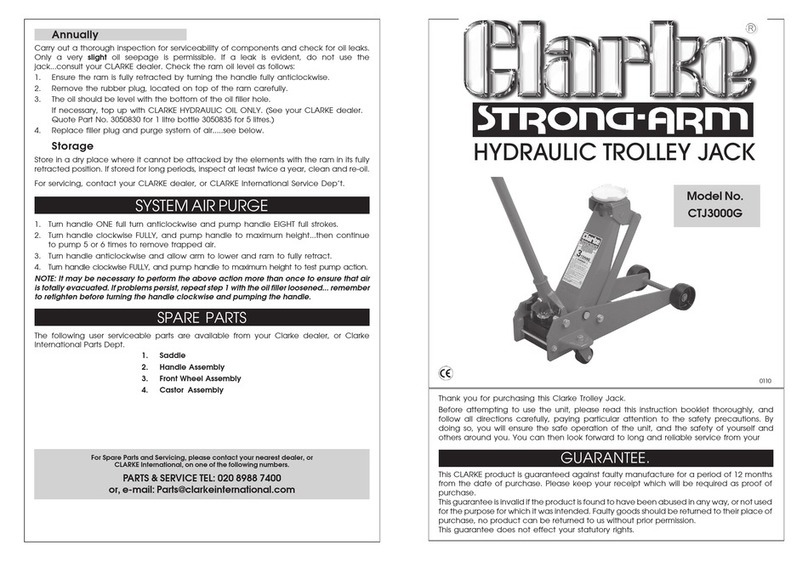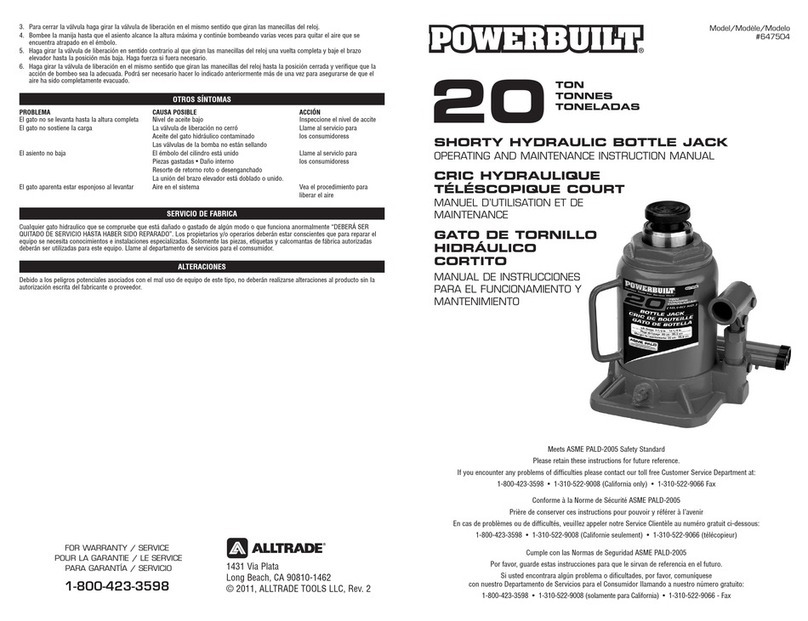INSTRUCTIONS DE MONTAGE
Installation du vérin hydraulique
1. Fixer le vérin hydraulique (12) sur la plate-forme du vérin (20)
à l’aide des boulons (17) et rondelles (18).
Fixation de la barre de verrouillage, du vérin hydraulique et de la pédale
1. Pour installer la barre de verrouillage, enlevez les goupilles fendue
(13) et rondelles des poteaux de plot. Alignez la barre de verrouillage
avec des poteaux de plot des deux côtés du plot et replacer les
goupilles fendue (13) et rondelles.
2. Retirer la goupille fendue (13) et la goupille de sécurité (14), abaisser
le cadre de levage (9) et aligner la tête du vérin hydraulique (12) avec
les trous du support situés sur la partie centrale inférieure du cadre
de levage. Remettre la goupille de sécurité (14) et la fixer avec la
goupille fendue (13).
3. Insérer la pédale (16) dans le vérin. Utiliser la vis (15) pour fixer la
pédale en position.
MODE D’EMPLOI
Mise en place du véhicule sur le dispositif de levage
1. Descendre complètement le cric. Ceci devrait permettre de le faire
rouler facilement sous le véhicule. Remarque : Consulter le manuel
du propriétaire du véhicule pour déterminer quels sont les points
de levage recommandés pour le véhicule en question.
2. Vérifier que le véhicule est bien équilibré. Répartir la charge
uniformément sur la sellette d’appui.
Actionnement du dispositif de levage
1. S’assurer que le véhicule est bien équilibré sur la sellette d’appui.
2. Tout en vérifiant que la manoeuvre ne présente aucun problème,
actionner à plusieurs reprises sur la pédale pour soulever le
véhicule à la hauteur voulue. Vérifier que le véhicule est suffisam-
ment haut pour engager la barre de verrouillage dans ses crans.
3. Aussitôt après avoir levé le véhicule, le maintenir avec des sangles
d’attache. Maintenir fermement le véhicule sur le dispositif de
levage à l’aide des sangles appropriées (sangles ayant une capac-
ité nominale de reprise de charge de 150%, non incluses).
Boulons
Descente du véhicule
1. Vérifier qu’il est possible de descendre le véhicule en éloignant
au préalable tout outil et materiel de l’aire de travail. S'assurer
que personne n'est à proximité du dispositif de levage.
2. Lever suffisamment le cric pour retirer la barre de verrouillage de
ses crans, puis la maintenir fermement avec la goupille fendue.
3. Tout en vérifiant que la
manoeuvre ne
présente aucun prob-
lème, actionner à
plusieurs reprises
sur la pédale pour
abaisser le véhicule à
la hauteur voulue.
Ne jamais travailler sur le véhicule ni s’en éloigner tant que la
barre de verrouillage n’est pas installée et qu’il n’est pas ferme-
ment maintenu en place par des sangles d’attache.
ENTRETIEN ET INSPECTION
1. Procéder à une inspection visuelle du vérin avant chaque utilisation pour s’assurer qu'il n’y a pas de
roues abîmées, des fuites, des pièces endommagées, desserrées ou manquantes.
2. Effectuer toute autre verification préconisée dans le mode d’emploi du produit en question.
3. Chaque vérin doit être inspecté immédiatement si l’on soupçonne qu’il a été soumis à une charge anor-
malement élevée ou en cas de choc.
4. Les propriétaires et utilisateurs doivent savoir que la réparation de ce matériel peut nécessiter une
expertise et des installations spéciales.
5. Il est recommandé d’effectuer une inspection annuelle du vérin et de remplacer toute pièce, autocollant
ou étiquette de mise en garde endommagée ou usagée par les pièces de rechange préconisées par le
fabricant.
6. Tout vérin qui semble avoir subi un quelconque dommage, est usé ou qui fonctionne anormalement,
doit être mis hors service sur-le-champ.
7. En raison des risques éventuels associés à ce type de matériel, aucune modification ne doit être
apportée à ce produit.
8. Ne pas mélanger deux types d’huile différentes. Lorsque l’on remet de l’huile dans le vérin, s’assurer
qu’aucune saleté ou autre substance ne puisse pénétrer dans le système hydraulique.
SYMPTOMES
Levage impossible de la charge Voir nº 1, 2 et 3 sous Guide de dépannage
Affaissement de la charge Voir nº 3 sous Guide de dépannage
Levage incomplet Voir nº 1 et 2 sous Guide de dépannage
Sensation de pompe « spongieuse »
sous la charge Voir nº 1 et 2 sous Guide de dépannage
Relèvement de la poignée sous la charge Voir nº 3 sous Guide de dépannage
Abaissement de la poignée sous la charge Voir nº 3 sous Guide dépannage
GUIDE DE DÉPANNAGE
1. Il est possible que le niveau de liquide en le vérin hydraulique soit insuffisant. Mettre le cric sur une
surface à niveau et en position basse, retirer le bouchon du réservoir et ajouter du liquide neuf pour
cric hydraulique jusqu’au niveau du trou de remplissage.
2. Il est possible qu’il y ait une prise d’air sur le vérin hydraulique. Ouvrir le purgeur sur deux tours com-
plets minimum. Actionner la poignée au minimum 20 fois pour purger l’air du système.
3. Il est possible que les valves ne ferment pas complètement. Pour régler les valves : A) Fermer le
purgeur. B) Avec le cric en position totalement basse, lever manuellement le bras aussi que possible.
C) Ouvrir le purgeur et laisser le bras redescendre en position basse.
10
9
14
12
9
13 13
16
15























